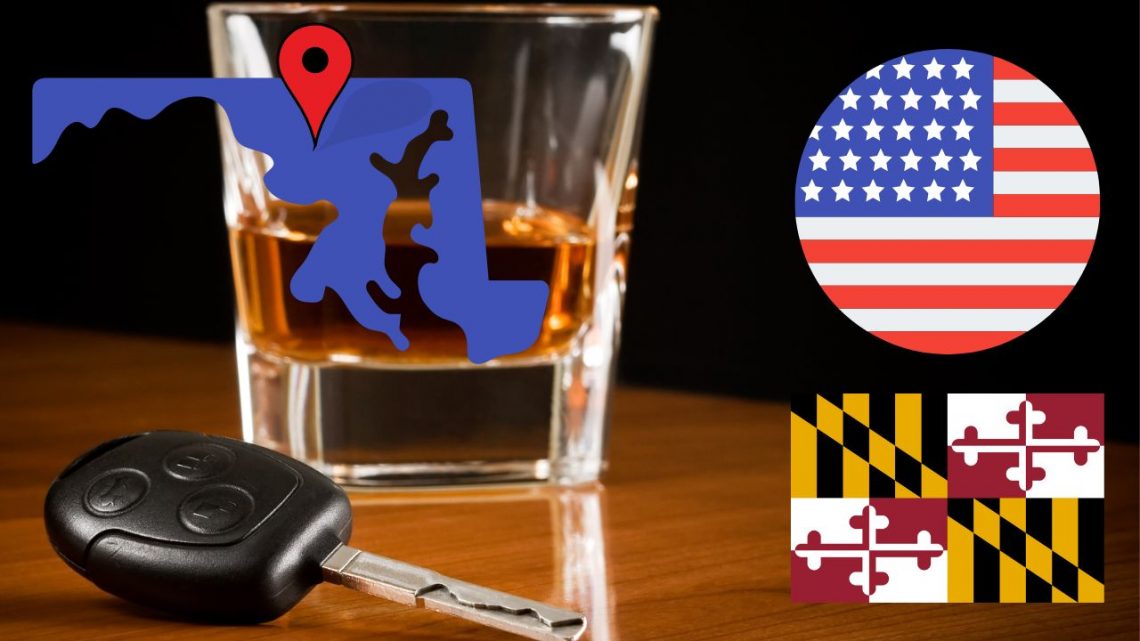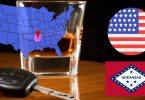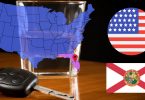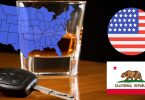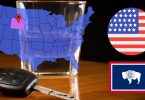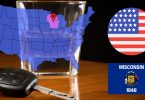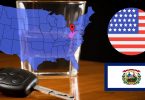In Maryland, operating a vehicle with a blood alcohol content (BAC) of 0.08%—equivalent to 80 milligrams of alcohol per 100 milliliters of blood or more—is classified as DUI (driving under the influence).
Please remember that this piece aims to inform readers about Maryland’s impaired driving laws. This article does not endorse or promote drunk driving in any state or region.
What is the legal alcohol limit for driving in Maryland?
In Maryland, the legal alcohol limit for driving varies based on the type of driver’s license and the driver’s age. These limits are set to ensure the safety of all road users and to reduce the risks associated with impaired driving. Below are the specific legal blood alcohol content (BAC) limits for different categories of drivers:
- Regular Drivers: The legal limit is 0.08% BAC. This applies to the majority of drivers operating personal vehicles.
- Commercial Drivers: For those holding a commercial driver’s license, the legal limit is stricter at 0.04% BAC, reflecting the higher responsibility associated with operating commercial vehicles.
- Minors (Under 21): Maryland enforces a zero-tolerance policy for underage drinking and driving. It is illegal for minors to drive with any detectable amount of alcohol in their system, aiming to discourage underage drinking and driving entirely.
Drink and Drive Penalties and Punishments in Maryland
In Maryland, the consequences of impaired driving are serious and multifaceted, aimed at deterring the dangerous behavior of driving under the influence of alcohol or drugs. Those apprehended for such offenses face a combination of immediate administrative actions and, upon conviction, further criminal penalties along with license sanctions. It’s crucial for drivers to understand these repercussions and the legal process that follows an arrest for impaired driving.
Key Information:
- Administrative Sanctions: Immediately upon arrest for impaired driving, drivers are subject to administrative penalties. This includes the issuance of an Order of Suspension for testing above the legal alcohol limit (0.08 BAC) or refusing to submit to chemical testing.
- Criminal Penalties and License Sanctions: Convictions bring additional penalties, including fines, imprisonment, and the assessment of points on the driver’s record, which can lead to license revocation or suspension.
Significant Updates:
- As of October 1, 2016, Maryland introduced significant changes to its drunk driving laws under the Drunk Driving Reduction Act of 2016, also known as Noah’s Law. These changes include heightened penalties and an expanded Ignition Interlock Program. For detailed information about these updates, it is advisable to visit the official state website.
Procedure Following a Traffic Stop:
- If suspected of driving under the influence, a law enforcement officer may request the driver to undergo field sobriety and portable breath tests. An arrest leads to the confiscation of the Maryland driver’s license and the issuance of a temporary paper license, pending further legal action.
Penalties for Specific Offenses:
- DUI Convictions: Penalties range from fines up to $1,000 and one year in jail for a first offense, escalating to higher fines and longer imprisonment for subsequent offenses. License revocation periods also increase with each offense.
- DWI Convictions: Penalties include fines, imprisonment, and license suspension, with the severity of the punishment increasing with each offense. Special rules apply for drivers under 21 and those transporting minors at the time of the offense.
Special Considerations:
- Underage Drivers: Those under 21 face strict zero-tolerance laws and mandatory participation in the Ignition Interlock Program for any violation of alcohol restrictions.
- Commercial Drivers: Additional disqualifications apply for commercial license holders, emphasizing the heightened responsibility of operating commercial vehicles.
Ignition Interlock Program:
- A key component of Maryland’s effort to reduce drunk driving, the Ignition Interlock Program requires drivers to pass a breath alcohol test before their vehicle can start. This program has been shown to significantly decrease re-arrest rates for impaired driving.
Given the complexity of these laws and the introduction of new legislation, individuals are encouraged to frequently consult the official state website for the most current information regarding impaired driving laws and penalties in Maryland. This ensures drivers are well-informed about the legal expectations and the potential consequences of driving under the influence.
How to Calculate if Your Alcohol Blood Limit is Legal in Maryland
In Maryland, law enforcement officials utilize several methods to determine if a driver is operating a vehicle under the influence of alcohol. The primary method is through the use of a chemical blood alcohol concentration (BAC) test, which measures the amount of alcohol present in the bloodstream. This can be done via a breathalyzer test at the time of the traffic stop or through a blood test following an arrest to obtain precise BAC levels. The legal limit in Maryland is 0.08% BAC for standard drivers, 0.04% for commercial drivers, and any detectable alcohol level is illegal for minors under 21.
To avoid the risks and legal consequences of impaired driving, I recommend two proactive measures to check your BAC level:
- Use a High-Quality Alcohol Breathalyzer: From my decade-long experience as a phlebotomist, the BACtrack S80 stands out for its reliability and accuracy. It is a Professional-Grade Breathalyzer that’s DOT & NHTSA Approved and FDA 510(k) Cleared, making it one of the most trusted devices on the market. Keeping a BACtrack S80 in your vehicle can serve as a valuable tool for assessing your BAC, helping Maryland drivers make informed decisions about their ability to drive safely.
- Utilize a BAC Calculator: In collaboration with fellow phlebotomists and web developers, I have developed an online BAC calculator designed to estimate your blood alcohol content based on the quantity of alcohol consumed, your weight, and the time elapsed since drinking. This tool can provide a rough estimate of your BAC, assisting you in making safer choices regarding alcohol consumption and driving.
It’s important to note that while both methods can offer a good indication of your BAC, neither can guarantee 100% accuracy due to individual variations in metabolism, food intake, and other factors. Therefore, if there’s any doubt about your sobriety, the safest decision is to not drive. These tools are meant to aid in responsible decision-making, potentially preventing the decision to drive while over the legal limit of 0.08% BAC. Always prioritize safety and the well-being of yourself and others on the road.
Ways to Avoid Driving with a High BAC in Maryland

Driving with a high Blood Alcohol Concentration (BAC) not only puts you and others at risk but also has significant legal consequences in Maryland. Fortunately, there are several safe and convenient alternatives to driving under the influence:
- Use Rideshare or Local Taxi Services: One of the easiest ways to avoid driving after consuming alcohol is by utilizing rideshare applications such as Uber or Lyft. These services offer a convenient and safe way to get home without the risk of driving impaired. Additionally, for those who prefer traditional taxi services, local companies like Taxi Hispano in Baltimore or Columbia Taxi Service in Columbia offer reliable transportation options. These services can be easily accessed through a phone call or their respective apps, ensuring you a safe ride home at any time.
- Designated Driver Services: If you find yourself in a situation where you’ve driven to a location and consumed alcohol, leaving your car behind might not be an option you’re comfortable with. In such cases, designated driver services offer a solution. Services like FreedomCar in Baltimore or Maryland Black Car in Columbia provide professional drivers who can drive you home in your own vehicle. This not only ensures your safety and that of others on the road but also keeps your car from being left unattended. To find a designated driver service in your area, a simple Google search for “designated driver service” followed by your city name will provide you with several options.
Utilizing these services not only helps in avoiding the risks associated with driving under the influence but also supports local businesses and professionals dedicated to keeping our roads safe. Remember, planning how to get home safely before heading out can make all the difference. Making the responsible choice not to drive while impaired is crucial for your safety and the safety of everyone on the road.
Sticking to DUI Laws in Maryland: Sad Statistics
In Maryland, DUI and DWI offenses are taken seriously, underscored by 2020 statistics revealing 567 fatal accidents linked to drunk driving. Of these, 32% involved drivers with BAC levels over 0.08%, and 21% exceeded 0.15%. Maryland’s strict DUI laws aim to curb such incidents, emphasizing the importance of monitoring your BAC before driving.
To ensure compliance with Maryland’s legal BAC limit, consider using a reliable breathalyzer. Alternatives like Uber, designated driver services, or taxis offer safe travel options.
Stay informed on DUI regulations by visiting Maryland’s Department of Transportation website. Misunderstandings about alcohol’s impact on driving safety persist, but awareness and responsible choices can significantly reduce DUI risks.
Even moderate alcohol consumption can impair driving abilities. Always prioritize safety by ensuring your BAC is within legal limits and opting for alternative transportation if in doubt. Keep up-to-date with Maryland’s DUI laws through official state resources.

